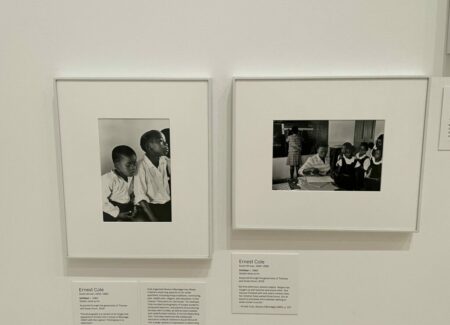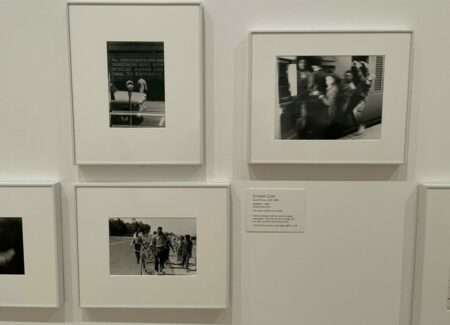JTF (just the facts): A single room presentation of works from Ernest Cole’s House of Bondage project, supported by other works by related artists and additional ephemera. On view in room 409 in the museum’s permanent collection galleries.
The following work are included in the show:
Ernest Cole:
- 26 gelatin silver prints, c1960
- 10 gelatin silver prints, c1970, 1970
- 2 photobooks (published by Random House/Ridge Press), 1967
Jeanne Moutoussamy-Ashe: 2 gelatin silver prints, 1977, 1978
Gavin Jantses: 10 screenprints, 1974-1975 (some incorporating reproductions of Cole’s photographs)
David Goldblatt: 5 gelatin silver prints, 1964, 1971, 1972
(vitrine)
- Henri Cartier-Bresson: 1 photobook, 1955
- Peter Magubane: 2 photobooks, 1978, 1979
- David Goldblatt: 1 photobook, 1973
- Omar Badsha ed.: 1 photobook, 1986
- Okwui Enwezor ed.: 1 photobook, 2013
(vitrine)
- 2 contact sheets
- 2 research notes
- 3 magazine spreads, 1978, 1967, 1968
- 1 photobook (Aperture reprint), 2022
(Installation shots below.)
Comments/Context: Several years ago now, the Museum of Modern Art moved away from its specific physical areas dedicated to particular mediums and reimagined its permanent collections galleries as a more integrated survey of art from the 1880s to the present. In the years since, the galleries have continue to rotate and be continually refreshed, with visitor favorites generally always on view, but new ideas, contexts, and connections introduced seasonally.
Photographically, this has meant that photographs are generally woven into larger art historical stories and placed into direct dialogue with artworks in other mediums, with only a few rooms intermittently dedicated to photographic themes. When we do find a photo room in the wandering flow, it is most often a tiny group show, with an overarching theme introduced and then supported by a selection of works by different photographers. But from time to time, the curators have also allowed a single photographer to take the lead, in something approaching a small solo presentation, with supporting works added to surround and broaden the potential discussion.
So, in the midst of the current installation of the permanent collection from the 1950s to the 1970s (on the museum’s fourth floor), we can now find a room primarily featuring Ernest Cole’s photographs of South Africa from the 1960s. These images originally took shape as the now-classic photobook House of Bondage, which was first published in 1967 and subsequently banned in South Africa in 1968. While the book ultimately fell out of print a few decades later (and has recently been reissued by Aperture), the incisive power of Cole’s images of Black life under apartheid hasn’t lost any of its sting.
House of Bondage was originally organized as a series of thematic chapters, but that structure has been slimmed down and largely eliminated here, in favor of a selection of prints installed in an up and down wave on the room’s long back wall, with pairs and clusters of images flowing into one another. Much of the durability of Cole’s images comes from their ability to see further than the surface; of course, he made some images of whites-only signage and white policemen hassling Black men about their pass books in the street, but many outsiders to South Africa also made photographs like these. Where Cole stands out is in his ability to make pictures that empathetically captured the subtleties and less obvious downstream results of living under apartheid, in a way that only an insider could really understand.
Almost every photograph is this relatively small installation shows us a complex, emotionally-layered scene, and then encourages us to ask why what we’re seeing is occurring, often answering those very questions with short captions or explanations. Why is a boy sleeping in class or a teacher frustrated and weary surrounded by students? Because the educational system for Blacks under apartheid was systematically underfunded and understaffed. Why are people seen waiting in long lines? Because bureaucratic systems made it difficult (and time consuming) to enroll a child in school or visit a doctor when sick. Why are young children taking care of babies and elderly women selling fruit in the markets? Because the older children are at school and the mothers are at work, leaving the child care to the youngest, and the elderly women are too old or ill to find work, and so must try to scratch up an illegal income in the markets. And why are the young boys hanging out in the streets? Because they have been left to fend for themselves, which of course leads to another photograph, of a boy begging on the sidewalk.
These kinds of cause-and-effect logic trees invisibly surround Cole’s photographs, creating a rich set of explanations for the quiet horrors he has documented. One image of an endless sea of small cinderblock houses in a township kicks off a series of follow ups. Additional images show us blank empty (and dark) interiors, a child sleeping outside a tent, and a stand selling bantu beer, and then a train covered with clinging passengers, a bunch of people walking with bicycles, and another trio of silhouetted people carrying water buckets on their heads. How are they all connected? The apartheid practice of uprooting people from their villages and forcing them to live in new townships out in semiarid desert areas had plenty of social and personal consequences: people had to travel long distances to find work in the cities (leading to the train and bicycle trips); they had to gather water from wells not located in the townships, sometimes walking nearly a mile at the end or beginning of their days (thus the water carrying); the houses had no furnishings and were hot in the summer, so many were lived in almost empty, leading to dark nights, bored people, and an interest in bantu beer (sold by the municipal government) to dull the ache of the existence. And even before the people got to the township, they may have lived in temporary tent cities with even less amenities, awaiting the completion of the construction. House of Bondage knits all these ideas together, in ways that are both photographically and intellectually sophisticated.
Stepping back from this main wall, the rest of the contents of room 409 have been included to provide context for the main installation of photographs. A pair of vitrines contains Cole’s influences (a photobook by Henri Cartier-Bresson), a few of his contact sheets and captions, books by his contemporaries in South Africa (Peter Magubane and David Goldblatt), and a few magazine spreads featuring Cole’s images. Nearby walls add a handful of prints of similar subject matter by Goldblatt, some 1970s era works by Jeanne Moutoussamy-Ashe and Gavin Jantses (both of whom took Cole’s photographs as inspiration), and a range of images Cole made in the early 1970s in New York on a grant from the Ford Foundation. All of this is secondary supporting material, but in theory it fills out the picture of what, how, and why Cole was doing what he was, and where it begins to fit in the larger arc of art responding to Black lives. That said, Cole’s photographs from House of Bondage don’t really need this packaging; the photographs (and text captions) can certainly speak (or shout) for themselves.
Part of what makes Cole’s photographs so durably powerful is the way that he sensitively sees the determination and resoluteness of the people subjected to the evils of the apartheid regime. From studying under the light of a paraffin lamp in a dark township to attentively participating in a conference of the National Council of African Women, Cole’s subjects refuse to give in to the situation and respond with a deep sense of humanity. To be sure, there is outrage simmering in these pictures, but Cole finds a way to tell that story in a way that celebrates the struggle. For those that have just come out of a room filled with 1950s assemblage works by Jasper Johns, Robert Rauschenberg, and others, Cole’s photographs boldly recenter the artistic conversation in the real fights for freedom that would take shape in many forms in the coming decade.
Collector’s POV: Ernest Cole’s work is represented by the Ernest Cole Family Trust, but without a website, it may be difficult for collectors to follow up directly with the estate. Connections also exist to Magnum (here), with which Cole was briefly associated. Cole’s work has little secondary market history; it was generally assumed that most of his negatives were lost, until a cache of negatives resurfaced in a Swedish bank vault in 2017.





























